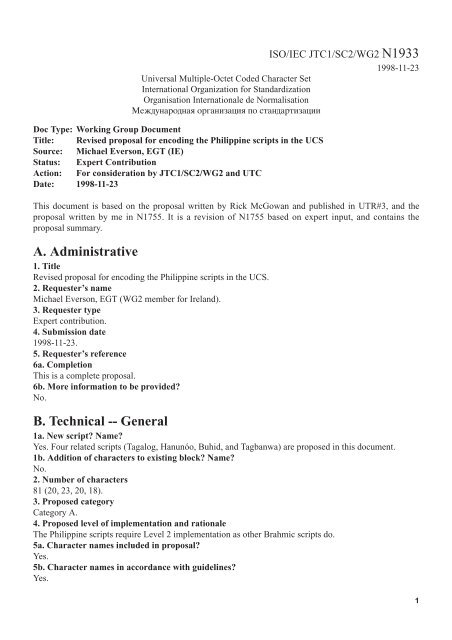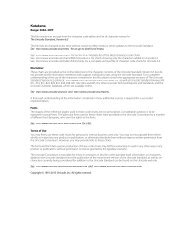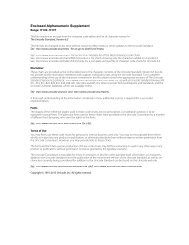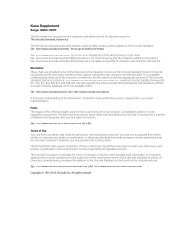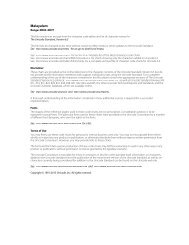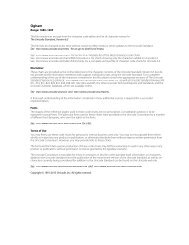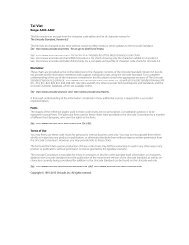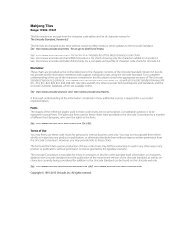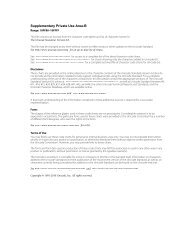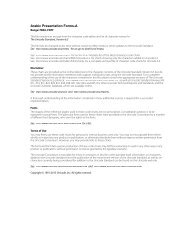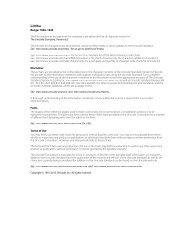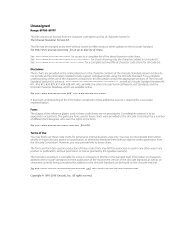n1933.qxp philippines - DKUUG standardizing
n1933.qxp philippines - DKUUG standardizing
n1933.qxp philippines - DKUUG standardizing
You also want an ePaper? Increase the reach of your titles
YUMPU automatically turns print PDFs into web optimized ePapers that Google loves.
ISO/IEC JTC1/SC2/WG2 N1933<br />
1998-11-23<br />
Universal Multiple-Octet Coded Character Set<br />
International Organization for Standardization<br />
Organisation Internationale de Normalisation<br />
Œåæäóíàðîäíàß îðãàíèçàöèß ïî ñòàíäàðòèçàöèè<br />
Doc Type: Working Group Document<br />
Title: Revised proposal for encoding the Philippine scripts in the UCS<br />
Source: Michael Everson, EGT (IE)<br />
Status: Expert Contribution<br />
Action: For consideration by JTC1/SC2/WG2 and UTC<br />
Date: 1998-11-23<br />
This document is based on the proposal written by Rick McGowan and published in UTR#3, and the<br />
proposal written by me in N1755. It is a revision of N1755 based on expert input, and contains the<br />
proposal summary.<br />
A. Administrative<br />
1. Title<br />
Revised proposal for encoding the Philippine scripts in the UCS.<br />
2. Requester’s name<br />
Michael Everson, EGT (WG2 member for Ireland).<br />
3. Requester type<br />
Expert contribution.<br />
4. Submission date<br />
1998-11-23.<br />
5. Requester’s reference<br />
6a. Completion<br />
This is a complete proposal.<br />
6b. More information to be provided?<br />
No.<br />
B. Technical -- General<br />
1a. New script? Name?<br />
Yes. Four related scripts (Tagalog, Hanunóo, Buhid, and Tagbanwa) are proposed in this document.<br />
1b. Addition of characters to existing block? Name?<br />
No.<br />
2. Number of characters<br />
81 (20, 23, 20, 18).<br />
3. Proposed category<br />
Category A.<br />
4. Proposed level of implementation and rationale<br />
The Philippine scripts require Level 2 implementation as other Brahmic scripts do.<br />
5a. Character names included in proposal?<br />
Yes.<br />
5b. Character names in accordance with guidelines?<br />
Yes.<br />
1
5c. Character shapes reviewable?<br />
Yes (see below).<br />
6a. Who will provide computerized font?<br />
Hector Santos via Michael Everson.<br />
6b. Font currently available?<br />
Yes.<br />
6c. Font format?<br />
TrueType.<br />
7a. Are references (to other character sets, dictionaries, descriptive texts, etc.) provided?<br />
Yes.<br />
7b. Are published examples (such as samples from newspapers, magazines, or other sources) of use<br />
of proposed characters attached?<br />
N1755 (the WG2 hardcopy, not the online version).<br />
8. Does the proposal address other aspects of character data processing?<br />
Yes (see below).<br />
C. Technical -- Justification<br />
1. Contact with the user community?<br />
Yes: Hector Santos. See http://www.bibingka.com/dahon.<br />
2. Information on the user community?<br />
See below.<br />
3a. The context of use for the proposed characters?<br />
Tagalog was formerly (until the mid-1700s) used to write Tagalog and Ilocano languages; Hanunóo,<br />
Buhid, and Tagbanwa are used today to write the Hanunóo, Buhid, and Tagbanwa languages.<br />
3b. Reference<br />
See bibliography below.<br />
4a. Proposed characters in current use?<br />
Yes<br />
4b. Where?<br />
In the Philippines. The scripts also enjoy some use in North America by Philippine communities for<br />
various purposes.<br />
5a. Characters should be encoded entirely in BMP?<br />
Yes.<br />
5b. Rationale<br />
Contemporary use and accordance with the Roadmap.<br />
6. Should characters be kept in a continuous range?<br />
Yes, they should be encoded in a single block as presented here.<br />
7a. Can the characters be considered a presentation form of an existing character or character<br />
sequence?<br />
No.<br />
7b. Where?<br />
7c. Reference<br />
8a. Can any of the characters be considered to be similar (in appearance or function) to an existing<br />
character?<br />
No. There is some similarity between the four scripts but the differences are striking enough to warrant<br />
against their unification.<br />
8b. Where?<br />
8c. Reference<br />
2
9a. Combining characters or use of composite sequences included?<br />
Yes.<br />
9b. List of composite sequences and their corresponding glyph images provided?<br />
No. Some information is in the hardcopy samples circulated to WG2 in N1755. Vowel signs combine<br />
with all letter characters; in some cases unique logotypes result from the combination.<br />
10. Characters with any special properties such as control function, etc. included?<br />
No.<br />
E. Proposal<br />
User community<br />
Tagalog is a script of the Philippines. It was formerly used to write the Tagalog, Bisaya, Ilocano, and<br />
other languages. The Tagalog language now utilizes the Latin script. The Tagalog script is distantly<br />
related to the southern Indian scripts, but the exact route by which they were brought to the Philippines is<br />
not certain. It seems that they may have been transported by way of the palaeographic scripts of Western<br />
Java between the 10th and 14th centuries. Written accounts of the Tagalog script by Spanish missionaries,<br />
and documents in Tagalog, are known from the period of initial Spanish incursion (mid-1500s). The<br />
Tagalog script had fallen out of normal use by the mid-1700s. It has three living descendants: the<br />
Hanunóo, Buhid (also called Mangyan), and Tagbanwa (also called Bisaya) scripts, also part of this<br />
proposal.<br />
Structure<br />
Vowel signs are used in a manner similar to that employed by other Brahmic scripts. The vowel I is<br />
written with a mark above, and the vowel U with an identical mark below, the associated consonant. The<br />
mark is known as kudlit or tulbok in Buhid and ulitan in Tagbanwa. The script has only the two vowel<br />
signs I and U, which are also used respectively to stand for the vowels E and O. Though all languages<br />
normally written with the Tagalog script have syllables possessing final consonants, they cannot normally<br />
be expressed in this script. Reforms to express final consonants with a virama character were proposed<br />
for the Tagalog script, but were rejected by native users, who considered the script adequate without it. A<br />
similar reform for the Hanunóo script seems to have been better received. These signs were not proposed<br />
for all of the scripts; because they are found in existing character sets (by Hector Santos), they are<br />
encoded here for Tagalog and Hanunóo. The HANUNOO PAMUDPOD has been used by the Hanunóo<br />
themselves; the inclusion of the Tagalog permits, at least, the representation of the texts proposing its<br />
addition (documents of historical interest) in UCS encoding. Other reforms, such as the addition of E and<br />
O vowel signs or the letter FA, have not been included here as they are wanting attestation (even in<br />
existing character sets). There is room in the tables for their later addition should it prove necessary.<br />
Directionality<br />
The Philippine scripts are read from left to right in horizontal lines running from top to bottom. They may<br />
be written either in that manner, or in vertical lines running from bottom to top, moving from left to right.<br />
In the latter case, the letters are written sideways so they may be read horizontally. This method of<br />
writing is probably due to the medium and writing implements used. Text is often scratched with a sharp<br />
instrument onto beaten strips of bamboo which are held pointing away from the body and worked from<br />
the proximal to distal ends, from left to right.<br />
Ordering<br />
UTR#3 states: “The alphabetical order of Tagalog is known from Tagbanwa speakers and is described in<br />
folktales. This order is used in the accompanying charts. The two vowel signs are added at the end of the<br />
3
alphabet.” The names list in UTR#3, however, is (except for the vowel signs) given in Latin alphabetical<br />
order (a, i, u, ba, da, ga, ha, ka, la, ma, na, nga, pa, sa, ta, wa, ya, -i, -u). Daniels & Bright give another<br />
ordering, “based on the 16th-century Tagalog sequence” (a, i, u, ha, pa, ka, sa, la, ra, ta, na, ba, ma, ga,<br />
da, ya, nga, wa). This proposal gives the characters in the traditional Brahmic order (a, i, u, ka, ga, nga,<br />
ta, da, na, pa, ba, ma, ya, ra, la, wa, sa, ha), which is followed in many sources, including Santos 1994<br />
and 1995 (source of the fonts used in this proposal). The accompanying chart is divided into four<br />
segments, from left to right: Tagalog, Hanunóo, Buhid, Tagbanwa. Each of these 2-column segments<br />
should be given a separate collection ID in annex A of ISO/IEC 10646.<br />
Processing<br />
The Philippine scripts are written from left to right and follow the usual Brahmic pattern. Consonants<br />
have an inherent /a/ vowel sound, and can be written with either a vowel sign or (in the case of Tagalog<br />
and Hanunóo) a null “vanishing vowel” sign. In some cases, the vowel signs simply rest over or under<br />
the consonants. In Hanunóo and Buhid, however, special conjoined glyphs are formed (Santos 1995).<br />
Punctuation<br />
Punctuation has been unified for the Philippine scripts. In the Hanunóo block, PHILIPPINE SINGLE<br />
PUNCTUATION and PHILIPPINE DOUBLE PUNCTUATION are encoded. Tagalog makes use only of the latter;<br />
Hanunóo, Buhid, and Tagbanwa make use of both of them.<br />
Code positions proposed in the table are based on my Roadmap to the BMP, version 2.10.<br />
Unicode Character Properties<br />
Spacing letters, category “Lo”, bidi category “L” (strong left to right)<br />
1380-138C, 138E-1391, 2960-2971, 29C0-29D1, 29E0-29EC, 29EE-29F0<br />
Non-spacing marks, category “Mn”, bidi category “ON” (other neutral); combining priorities in<br />
parentheses:<br />
1392, 2972, 29D2, 29F2 (232)<br />
1393, 2973, 29D3, 29F3 (222)<br />
1394 (9)<br />
Spacing marks, category “Mc”, bidi category “ON” (other neutral); combining priorities in parentheses:<br />
2974 (9)<br />
Symbols, category “Po”, bidi category “L” (strong left to right)<br />
2975-2976<br />
Bibliography<br />
Kuipers, Joel C., and Ray McDermott. 1996. “Insular Southeast Asian Scripts”, in Peter T. Daniels and<br />
William Bright, eds. The world’s writing systems. New York; Oxford: Oxford University Press.<br />
ISBN 0-19-507993-0<br />
Faulmann, Carl. 1990 (1880). Das Buch der Schrift. Frankfurt am Main: Eichborn. ISBN 3-8218-1720-8<br />
Francisco, Juan R. 1973. Philippine Palaeography. Philippine Journal of Linguistics, Special Monograph<br />
Issue Number 3. Quezon City: Linguistic Society of the Philippines.<br />
Haarmann, Harald. 1990. Die Universalgeschichte der Schrift. Frankfurt: Campus. ISBN 3-593-34346-0<br />
Nakanishi, Akira. 1990. Writing systems of the world: alphabets, syllabaries, pictograms. Rutland, VT:<br />
Charles E. Tuttle. ISBN 0-8048-1654-9<br />
Santos, Hector. 1994. The Tagalog script. (Ancient Philippine Scripts Series; 1). Los Angeles: Sushi Dog<br />
Graphics.<br />
Santos, Hector. 1995. The living scripts. (Ancient Philippine Scripts Series; 2). Los Angeles: Sushi Dog<br />
4
Proposal to encode Philippine scripts in the UCS<br />
Graphics.<br />
Unicode Consortium. 1992. Unicode Technical Report #3: exploratory proposals.<br />
Wolf, Edwin, II, ed. 1947. Doctrina christiana: the first book printed in the Philippines, Manila 1593. A<br />
facsimile of the copy in the Lessing J. Rosenwald Collection. Washington, DC: Library of Congress.<br />
Sample from Wolf 1947:85<br />
5
Proposal to encode Philippine scripts in the UCS<br />
Sample from Santos 1994, illustrating a page from Francisco Lopez’ Libro a naisuratan amin ti bagas ti<br />
Dotrina Cristiana, 1620. Note his implementation of the cruciform VIRAMA.<br />
6
Proposal to encode Philippine scripts in the UCS<br />
Sample from Santos 1995. On the left, Hanunóo; on the right, Buhid, showing the consonants in<br />
combination with vowel signs, including special logotypes in the with the vowel signs I and U.<br />
7
Proposal for Tagalog, Hanunóo, Buhid and Tagbanwa Scripts<br />
0<br />
1<br />
2<br />
3<br />
4<br />
5<br />
6<br />
7<br />
8<br />
9<br />
A<br />
B<br />
C<br />
D<br />
E<br />
F<br />
138 139 296 297 29C 29D 29E 29F<br />
€ ° À Ð à ð<br />
‘ ¡ ± Á Ñ á<br />
‚ ’Ì ¢ ²Ì  ÒÌ â òÌ<br />
ƒ “Ì £ ³Ì à ÓÌ ã óÌ<br />
„ ”Ì ¤ Ì´ Ä ä<br />
… ¥ µ Å å<br />
† ¦ Æ æ<br />
‡ § Ç ç<br />
ˆ ¨ È è<br />
‰ © É é<br />
Š ª ~ ê<br />
‹ « Ë ë<br />
Œ ¬ Ì ì<br />
Í<br />
Ž ® Î î<br />
¯ Ï ï<br />
G = 00<br />
P = 00<br />
5
Proposal for Tagalog, Hanunóo, Buhid and Tagbanwa Scripts<br />
dec<br />
hex<br />
Name<br />
dec<br />
hex<br />
Name<br />
80<br />
81<br />
82<br />
83<br />
84<br />
85<br />
86<br />
87<br />
88<br />
89<br />
8A<br />
8B<br />
8C<br />
8D<br />
8E<br />
8F<br />
90<br />
91<br />
92<br />
93<br />
94<br />
95<br />
96<br />
97<br />
98<br />
99<br />
9A<br />
9B<br />
9C<br />
9D<br />
9E<br />
9F<br />
60<br />
61<br />
62<br />
63<br />
64<br />
65<br />
66<br />
67<br />
68<br />
69<br />
6A<br />
6B<br />
6C<br />
6D<br />
6E<br />
6F<br />
70<br />
71<br />
72<br />
73<br />
74<br />
75<br />
76<br />
77<br />
78<br />
79<br />
7A<br />
7B<br />
7C<br />
7D<br />
7E<br />
7F<br />
TAGALOG LETTER A<br />
TAGALOG LETTER I<br />
TAGALOG LETTER U<br />
TAGALOG LETTER KA<br />
TAGALOG LETTER GA<br />
TAGALOG LETTER NGA<br />
TAGALOG LETTER TA<br />
TAGALOG LETTER DA<br />
TAGALOG LETTER NA<br />
TAGALOG LETTER PA<br />
TAGALOG LETTER BA<br />
TAGALOG LETTER MA<br />
TAGALOG LETTER YA<br />
(This position shall not be used)<br />
TAGALOG LETTER LA<br />
TAGALOG LETTER WA<br />
TAGALOG LETTER SA<br />
TAGALOG LETTER HA<br />
TAGALOG VOWEL SIGN I<br />
TAGALOG VOWEL SIGN U<br />
TAGALOG SIGN VIRAMA<br />
(This position shall not be used)<br />
(This position shall not be used)<br />
(This position shall not be used)<br />
(This position shall not be used)<br />
(This position shall not be used)<br />
(This position shall not be used)<br />
(This position shall not be used)<br />
(This position shall not be used)<br />
(This position shall not be used)<br />
(This position shall not be used)<br />
(This position shall not be used)<br />
HANUNOO LETTER A<br />
HANUNOO LETTER I<br />
HANUNOO LETTER U<br />
HANUNOO LETTER KA<br />
HANUNOO LETTER GA<br />
HANUNOO LETTER NGA<br />
HANUNOO LETTER TA<br />
HANUNOO LETTER DA<br />
HANUNOO LETTER NA<br />
HANUNOO LETTER PA<br />
HANUNOO LETTER BA<br />
HANUNOO LETTER MA<br />
HANUNOO LETTER YA<br />
HANUNOO LETTER RA<br />
HANUNOO LETTER LA<br />
HANUNOO LETTER WA<br />
HANUNOO LETTER SA<br />
HANUNOO LETTER HA<br />
HANUNOO VOWEL SIGN I<br />
HANUNOO VOWEL SIGN U<br />
HANUNOO SIGN PAMUDPOD<br />
PHILIPPINE SINGLE PUNCTUATION<br />
PHILIPPINE DOUBLE PUNCTUATION<br />
(This position shall not be used)<br />
(This position shall not be used)<br />
(This position shall not be used)<br />
(This position shall not be used)<br />
(This position shall not be used)<br />
(This position shall not be used)<br />
(This position shall not be used)<br />
(This position shall not be used)<br />
(This position shall not be used)<br />
D7<br />
D8<br />
D9<br />
DA<br />
DB<br />
DC<br />
DD<br />
DE<br />
DF<br />
E0<br />
E1<br />
E2<br />
E3<br />
E4<br />
E5<br />
E6<br />
E7<br />
E8<br />
E9<br />
EA<br />
EB<br />
EC<br />
ED<br />
EE<br />
EF<br />
F0<br />
F1<br />
F2<br />
F3<br />
F4<br />
F5<br />
F6<br />
F7<br />
F8<br />
F9<br />
FA<br />
FB<br />
FC<br />
FD<br />
FE<br />
FF<br />
(This position shall not be used)<br />
(This position shall not be used)<br />
(This position shall not be used)<br />
(This position shall not be used)<br />
(This position shall not be used)<br />
(This position shall not be used)<br />
(This position shall not be used)<br />
(This position shall not be used)<br />
(This position shall not be used)<br />
TAGBANWA LETTER A<br />
TAGBANWA LETTER I<br />
TAGBANWA LETTER U<br />
TAGBANWA LETTER KA<br />
TAGBANWA LETTER GA<br />
TAGBANWA LETTER NGA<br />
TAGBANWA LETTER TA<br />
TAGBANWA LETTER DA<br />
TAGBANWA LETTER NA<br />
TAGBANWA LETTER PA<br />
TAGBANWA LETTER BA<br />
TAGBANWA LETTER MA<br />
TAGBANWA LETTER YA<br />
(This position shall not be used)<br />
TAGBANWA LETTER LA<br />
TAGBANWA LETTER WA<br />
TAGBANWA LETTER SA<br />
(This position shall not be used)<br />
TAGBANWA VOWEL SIGN I<br />
TAGBANWA VOWEL SIGN U<br />
(This position shall not be used)<br />
(This position shall not be used)<br />
(This position shall not be used)<br />
(This position shall not be used)<br />
(This position shall not be used)<br />
(This position shall not be used)<br />
(This position shall not be used)<br />
(This position shall not be used)<br />
(This position shall not be used)<br />
(This position shall not be used)<br />
(This position shall not be used)<br />
(This position shall not be used)<br />
C0<br />
C1<br />
C2<br />
C3<br />
C4<br />
C5<br />
C6<br />
C7<br />
C8<br />
C9<br />
CA<br />
CB<br />
CC<br />
CD<br />
CE<br />
CF<br />
D0<br />
D1<br />
D2<br />
D3<br />
D4<br />
D5<br />
D6<br />
BUHID LETTER A<br />
BUHID LETTER I<br />
BUHID LETTER U<br />
BUHID LETTER KA<br />
BUHID LETTER GA<br />
BUHID LETTER NGA<br />
BUHID LETTER TA<br />
BUHID LETTER DA<br />
BUHID LETTER NA<br />
BUHID LETTER PA<br />
BUHID LETTER BA<br />
BUHID LETTER MA<br />
BUHID LETTER YA<br />
BUHID LETTER RA<br />
BUHID LETTER LA<br />
BUHID LETTER WA<br />
BUHID LETTER SA<br />
BUHID LETTER HA<br />
BUHID VOWEL SIGN I<br />
BUHID VOWEL SIGN U<br />
(This position shall not be used)<br />
(This position shall not be used)<br />
(This position shall not be used)<br />
Group 00 Plane 00 Row XX<br />
6


